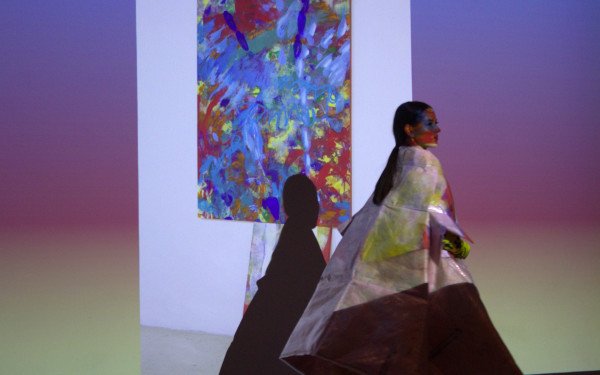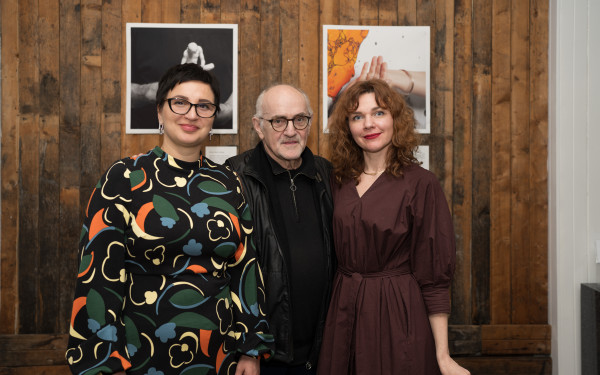Don’t Steal This: A Story of Appropriation
Indigenous Artisans Showcased at Fashion Preview
“I love the jewelry so much, I married the jewelry,” Konwatsitsa:wi Meloche said, laughing.
She held up a buckle with inlaid turquoise, coral and silver, gleaming under the fluorescent lights on the fifth floor of Oglivy’s last Thursday.
The handmade chokers, earrings and pendants on a table in front of the Mohawk public speaker each featured characteristics of a sun-faced god. The jewels were created by indigenous artisans and came all the way from Zuni, a New Mexican pueblo, where Meloche’s ex-husband still lives.
“This is like a collection of art,” she said looking down at the pieces.
With her suggestions for new designs, Meloche’s in-laws expanded their designs to intricate dangling earrings and long chains. Some pieces substituted colours, such as changing turquoise for the purple of the Aionwá:tha Wampum Belt, which symbolizes the founding of the Iroquois Confederacy.
Her display was set up beside about a dozen fashion artisans, almost all based in Montreal, selling and showcasing local-made tissues, sunglasses and bow-ties. She and David Charette, a 23-year-old beadworker living in Ottawa, were the only indigenous artisans at the event.
“Probably one of the biggest reasons for me to be here is for authenticity,” she said in the foyer of the fifth floor of Oglivy’s, a high-end department store in downtown Montreal. Fashion shows were underway in a neighbouring room.
Meloche, a leader and Concordia graduate in Education Studies, smiled radiantly, proud to be displaying the work, but hesitated at the thought of cameras. Years ago a group of artisans from the Philippines began producing-similar looking pieces for one-tenth of the price, she said.
In the United States, items that aren’t made by Native Americans can’t claim to be. Indigenous artists formed a council in the 1990s and pushed for a law against the misrepresentation of items not made by indigenous artisans.
“When you see people, like Urban Outfitters—it’s so sad,” she said. “There’s a reserve across the waters.
“In my experience, people still judge us as not working, on welfare—all these stereotypical, often not very kind comments,” Meloche said. “But yet, when a non-Native produces what Natives create, the non-Natives will buy from the non-Native. That’s the irony.”
Meloche and Charette are the first indigenous artists to present at the Fashion Preview. The fourth edition of the event took place from Oct. 13 to 15. It began two years ago, hosting summer and winter preview events.
“Exclusion is unconscious,” Meloche said. “Emanuela made it happen to include us.”
Emanuela Lolli, who runs a communications company, founded Fashion Preview after Montreal Fashion Week called it quits in 2013.
Part of Fashion Preview’s mandate is to bring together different cultures, Lolli said. She hopes to have more indigenous creators in the future.
“For me, having a presence of indigenous creators is very important because I really love their message, I love what’s behind every object,” Lolli said. “And above all their objects are handmade.”
“Beadwork is an expression of who you are, in how you wear it,” said David Charette about the beaded chains, necklaces and body-pieces on display at the event.
Charette, an Ojibwe, lives in Ottawa, but is from Manitoulin Island on Lake Huron.
“Everyone wears those geometric [patterned] shirts with arrows and all that stuff, and we never got credit,” Charette said, wearing a customized beaded necklace with a large beaded pendant dedicated to deadmau5. The beadworker has plans to expand the collection with pieces for Major Lazer and Skrillex.
“They shouldn’t be scared, they should exhibit their work,” Lolli said. Designers are being pushed to look into indigenous cultures, which are increasingly trendy in fashion.
“It’s getting up there, our work is being shown all over now. I want to keep going with this,” Charette said. “I think it’ll work out.
“I’ll share my work. As long as it’s out there, it doesn’t matter to me.”
But consequences of centuries of oppression and state programs like residential schools are still present in the way artists value their work, Meloche said.
The government-sponsored schools intended to turn First Nations and Inuit children into whitewashed Canadians have a long history in Canada, but recommendations for reconciliation were only released this summer in the Truth and Reconciliation Commission of Canada.
Residential schools have been called a cultural genocide. About 6,000 children died in them, and many experienced sexual violence.
“We see people who’ve been treated like they’re less for generations and generations, then they begin to believe it, then they begin to accept it,” Meloche said.
Some artists will sell their work on the street for a fraction of the value, even though they’re highly-skilled, she said.
“What happens is, some non-Indians, who see a market, begin to mass-produce—and they don’t want to hire the Native to do it,” Meloche said. “That’s part of the disrespect of fashion, the copycatting and the cultural appropriation that we totally despise.”
Here, Meloche points to Urban Outfitters. A faux-designer chain of stores—which are too large, with catalogues too diverse to be considered boutiques—that tries to amalgamate the young, trendsetting designs of local shops.
“To see Urban Outfitters make a heck of a trend and a billion dollars, but it’s taking our concepts without giving back,” Meloche said. “What is their social and community responsibility?”
In 2012, the Navajo Nation sued Urban Outfitters for using its name to brand products, including underwear and flasks, claiming it goes against the federal Indian Arts and Crafts Act. The case is still going on.
Before the lawsuit was filed, Sasha Houston Brown of the Santee Sioux Nation wrote an open letter to Urban Outfitters in 2011, denouncing their use of the nation’s name for marketing, specifically since the nation trademarked the Navajo name.
“[The] tacky products you are currently selling referencing Native America make a mockery of our identity and unique cultures,” read Brown’s letter to the company’s CEO.
Native American identities have been used in advertising and by brands like Ralph Lauren, Victoria’s Secret and Paul Frank, appropriating and sexualizing indigenous symbols and restricted items, like headdresses and patterns, as well as mascots for sports teams like the Washington Redskins and Cleveland Indians.
Meloche said she saw Navajo baskets, which have spiritual significance to the nation, nailed to a wall in a downtown Urban Outfitters.
“They work so hard to make these baskets,” Meloche said. “I walked into the store and said, ‘Would you nail a bible to the wall?’
“Even though I’m not Navajo, it’s disrespectful to me, because I know, and you probably know, that they’re not making one red penny on this.”

_600_832_s.png)




